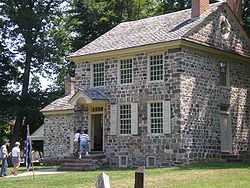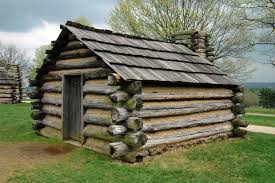Valley Forge National Historical Park
Introduction
Text-to-speech Audio
Images
George Washington's Headquarters at Valley Forge

One of the huts a soldier slept in at Valley Forge

Backstory and Context
Text-to-speech Audio
After winning a strategic victory over the British in early December at the battle of White Marsh, Washington had to pull his troops from their encampment to a more secure location to make camp for the winter. Although many sites were proposed, in the end Washington chose Valley Forge, which was Northwest of Philadelphia, for two reasons. One was to keep British raiding and foraging parties out of the interior of Pennsylvania, the other being that it was at enough distance to protect the area against British ambushes. With two densely forested plateaus, and the Schuylkill River in the north, Valley Forge was a relatively easy area to defend.
Washington’s army however was weary from forced marches, ill equipped and poorly fed. Only one in three Continental soldiers had shoes, and many of them had left bloody footprints from marching. When the grounds had been selected for brigade encampments and defense lines were drawn up, the troops began building shelters to withstand the long Pennsylvania winter. These were mainly huts made from logs and were basically one room log cabins. While they did provide protection from the cold, they were damp and wet.
The army’s food supplies were also relatively low, and soldiers received inadequate rations of meat and bread. Even animals suffered too, about 700 horses died by the end of the winter of 1778. Soldiers were poorly clothed as well. Many wounded men from previous battles died of exposure. Diseases such as typhoid, smallpox, pneumonia and dysentery were rampant throughout the camp. As many as 2,500 American soldiers died in the harsh winter of 1777-78. Conditions in the camp were so horrible during the winter, that many began to criticize Washington for his inability to advance the effort of the war.
Ironically, Washington responded saying that if the people were unsatisfied with him, he would retire to Mount Vernon. This renewed people’s trust in Washington as a commander. Congress sent additional food and supplies. To add on to the newly boosted morale, French reinforcements came to aid in the fight against the British. More importantly, it transformed the Continental army from a ragtag band of amateur troops into an 18th century military force capable of defeating the British in open battle.
In 1893, Valley Forge was made into a national historical park so as to preserve the memory and sacrifice of the brave men who endured the hardships of the long grueling winter. Many of the huts and other buildings have been restored and visitors can be given a hands-on experience of what life was like as an American soldier in the late 18th century.
